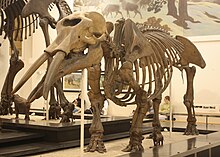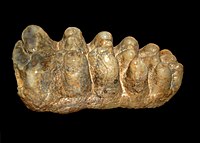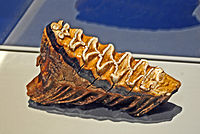Gomphothere
| Gomphothere Temporal range:Late Oligocene-Holocene
| |
|---|---|

| |
| Specimen ofGomphotheriumproductumat theAmerican Museum of Natural History | |

| |
| NotiomastodonplatensisCentro Cultural del Bicentenario de Santiago del Estero in Argentina | |
| Scientific classification | |
| Domain: | Eukaryota |
| Kingdom: | Animalia |
| Phylum: | Chordata |
| Class: | Mammalia |
| Order: | Proboscidea |
| Superfamily: | †Gomphotherioidea |
| Family: | †Gomphotheriidae (Hay, 1922)A. Cabrera1929 |
| Genera | |
| |
Gomphotheresare an extinct group ofproboscideansrelated to modern elephants. They were widespread acrossAfro-EurasiaandNorth Americaduring theMioceneandPlioceneepochs and dispersed intoSouth Americaduring thePleistoceneas part of theGreat American Interchange.Gomphotheres are aparaphyleticgroup that is ancestral toElephantidae,which contains modern elephants, as well asStegodontidae.While most famous forms such asGomphotheriumhad long lower jaws with tusks, which is theancestral conditionfor the group, some later members developed shortened (brevirostrine) lower jaws with either vestigial or no lower tusks, looking very similar to modern elephants, an example ofparallel evolution,which outlasted the long-jawed gomphotheres. By the end of theEarly Pleistocene,gomphotheres became extinct inAfro-Eurasia,with the last two genera,Cuvieroniusranging from southern North America to western South America, andNotiomastodonhaving a wide range over most of South America until the end of the Pleistocene around 12,000 years ago, when they became extinct following the arrival of humans.
The name "gomphothere" comes fromAncient Greekγόμφος(gómphos), "peg, pin; wedge; joint" plusθηρίον(theríon), "beast".
Description
[edit]

Gomphotheres differed from elephants in theirtoothstructure, particularly the chewing surfaces on themolarteeth. The teeth are considered to bebunodont,that is, having rounded cusps.[1]They are thought to have chewed differently from modern elephants, using an oblique movement (combining back to front and side to side motion) over the teeth rather than the proal movement (a forwards stroke from the back to the front of the lower jaws) used by modern elephants and stegodontids.[2]Like modern elephants and other members ofElephantimorpha,gomphotheres had horizontal tooth replacement, where teeth would progressively migrate towards the front of the jaws before they were taken the place of by more posterior teeth. Unlike modern elephants, many gomphotheres retained permanent premolar teeth[3]though they were absent in some gomphothere genera.[4]Earlier gomphotheres had lower jaws with an elongatemandibular symphysisand lower tusks, theprimitivecondition for members ofElephantimorpha.Later members developed shortened (brevirostrine) lower jaws and/or vestigial or no lower tusks, a convergent process that occurred multiple times among gomphotheres, as well as other members of Elephantimorpha.[4]The incisors and long lower jaws of primitive gomphotheres were likely used for cutting vegetation, while brevirostrine gomphotheres relied on their trunks to acquire food similar to modern elephants.[5]
-
Largely unworn molar ofGomphotherium angustidens,a "trilophodont gomphothere"
-
Worn molar ofGomphotherium angustidens
-
Molar ofTetralophodon,a "tetralophodont gomphothere"
-
Molar of a modern African elephant (Loxodonta) for comparison
Taxonomy
[edit]"Gomphotheres" are assigned to their own family, Gomphotheriidae, but are widely agreed to be aparaphyleticgroup. The familiesChoerolophodontidaeandAmebelodontidae(the latter of which includes "shovel tuskers" with flattened lower tusks likePlatybelodon) are sometimes considered gomphotheressensu lato,[6][7][8]though some authors argue that Amebelodontidae should be sunk into Gomphotheriidae.[9]Gomphotheres are divided into two informal groups, "trilophodont gomphotheres", and "tetralophodont gomphotheres". "Tetralophodont gomphotheres" are distinguished from "trilophodont gomphotheres" by the presence of four ridges on the fourth premolar and on the first and second molars, rather than the three present in trilophodont gomphotheres.[6]Some authors choose to exclude "tetralophodont gomphotheres" from Gomphotheriidae, and instead assign them to the groupElephantoidea.[6]"Tetralophodont gomphotheres" are thought to have evolved from "trilophodont gomphotheres", and are suggested to be ancestral toElephantidae,the group which contains modern elephants, as well asStegodontidae.[10]
While the North American long jawed proboscideansGnathabelodon,EubelodonandMegabelodonbeen assigned to Gomphotheriidae in some studies[4][11]other studies suggest that they should be assigned to Amebelodontidae (Eubelodon, Megabelodon) or Choerolophodontidae (Gnathabelodon).[5]
Cladogram ofElephantimorphaafter Li et al. 2023, showing aparaphyleticGomphotheriidae.[5]
| Elephantimorpha |
| |||||||||||||||||||||||||||||||||||||||||||||
Ecology
[edit]Gomphotheres are generally supposed to have been flexible feeders, with the various species having differingbrowsing,mixed feeding andgrazingdiets, with the dietary preference of individual species and populations being shaped by local factors such as climactic conditions and competition.[12]Analysis of the tusks of a maleNotiomastodonindividual suggest that it underwentmusth,similar to modern elephants.[13]Notiomastiodonis also suggested to have lived in social family groups, like modern elephants.[14]
Evolutionary history
[edit]Gomphotheres originated in Afro-Arabia during the mid-Oligocene,with remains from theShumaysi Formationin Saudi Arabia dating to around 29-28 million years ago. Gomphotheres were uncommon in Afro-Arabia during the Oligocene.[15]Gomphotheres arrived in Eurasia after the connection of Afro-Arabia and Eurasia during the Early Miocene around 19 million years ago,[16]in what is termed the "Proboscidean Datum Event".Gomphotheriumarrived in North America around 16 million years ago,[17]and is suggested to be the ancestor of later New World gomphothere genera.[18]"Trilophodont gomphotheres" dramatically declined during the Late Miocene, likely due to the increasingC4grass-dominated habitats,[16]while during the Late Miocene "tetralophodont gomphotheres" were abundant and widespread in Eurasia, where they represented the dominant group of proboscideans.[19]All trilophodont gomphotheres, with the exception of the AsianSinomastodon,became extinct in Eurasia by the beginning of thePliocene,[20]along with the global extinction of the "shovel tusker" amebelodontids.[21]The last gomphotheres in Africa, represented by the "tetralophodont gomphothere" genusAnancus,became extinct around the end of the Pliocene and beginning of the Pleistocene.[22]The New World gomphothere generaNotiomastodonandCuvieroniusdispersed into South America during thePleistocene,around or after 2.5 million years ago as part of theGreat American Biotic Interchangedue to the formation of theIsthmus of Panama,becoming widespread across the continent.[23]The last gomphothere native to Europe,Anancus arvernensis[24]became extinct during the Early Pleistocene, around 1.6–2 million years ago[25][26]Sinomastodonbecame extinct at the end of theEarly Pleistocene,around 800,000 years ago.[27]From the latter half of the Early Pleistocene onwards, gomphotheres were extirpated from most of North America, likely due to competition withmammothsandmastodons.[12]
The extinction of gomphotheres in Afro-Eurasia has generally been supposed to be the result the expansion of Elephantidae andStegodon.[20][28]The morphology of elephantid molars being more efficient than gomphotheres in consuming grass, which became more abundant during the Pliocene and Pleistocene epochs.[28]In southern North America, Central America and South America, gomphotheres did not become extinct until shortly after the arrival of humans to the Americas, approximately 12,000 years ago, as part of theLate Pleistocene megafauna extinctionsof most large mammals across the Americas. Bones of the last gomphothere genera,CuvieroniusandNotiomastodon,dating to shortly before their extinction have been found associated with human artifacts, suggesting that hunting may have played a role in their extinction.[23]
References
[edit]- ^Buckley, Michael; Recabarren, Omar P.; Lawless, Craig; García, Nuria; Pino, Mario (November 2019)."A molecular phylogeny of the extinct South American gomphothere through collagen sequence analysis".Quaternary Science Reviews.224:105882.Bibcode:2019QSRv..22405882B.doi:10.1016/j.quascirev.2019.105882.
- ^Saegusa, Haruo (March 2020)."Stegodontidae and Anancus: Keys to understanding dental evolution in Elephantidae".Quaternary Science Reviews.231:106176.Bibcode:2020QSRv..23106176S.doi:10.1016/j.quascirev.2020.106176.S2CID214094348.
- ^Sanders, William J. (2018-02-17)."Horizontal tooth displacement and premolar occurrence in elephants and other elephantiform proboscideans".Historical Biology.30(1–2): 137–156.Bibcode:2018HBio...30..137S.doi:10.1080/08912963.2017.1297436.ISSN0891-2963.
- ^abcMothé, Dimila; Ferretti, Marco P.; Avilla, Leonardo S. (12 January 2016)."The Dance of Tusks: Rediscovery of Lower Incisors in the Pan-American Proboscidean Cuvieronius hyodon Revises Incisor Evolution in Elephantimorpha".PLOS ONE.11(1): e0147009.Bibcode:2016PLoSO..1147009M.doi:10.1371/journal.pone.0147009.PMC4710528.PMID26756209.
- ^abcLi, Chunxiao; Deng, Tao; Wang, Yang; Sun, Fajun; Wolff, Burt; Jiangzuo, Qigao; Ma, Jiao; Xing, Luda; Fu, Jiao (2023-11-28),"Longer mandible or nose? Co-evolution of feeding organs in early elephantiforms",eLife,12,doi:10.7554/eLife.90908.1,retrieved2024-05-29
- ^abcShoshani, J.;Tassy, P. (2005). "Advances in proboscidean taxonomy & classification, anatomy & physiology, and ecology & behavior".Quaternary International.126–128: 5–20.Bibcode:2005QuInt.126....5S.doi:10.1016/j.quaint.2004.04.011.
- ^Wang, Shi-Qi; Deng, Tao; Ye, Jie; He, Wen; Chen, Shan-Qin (2016). "Morphological and ecological diversity ofAmebelodontidae(Proboscidea, Mammalia) revealed by a Miocene fossil accumulation of an upper-tuskless proboscidean ".Systematic Palaeontology.15(8) (Online ed.): 601–615.doi:10.1080/14772019.2016.1208687.S2CID89063787.
- ^Mothé, Dimila; Ferretti, Marco P.; Avilla, Leonardo S. (12 January 2016)."The dance of tusks: Rediscovery of lower incisors in the pan-American proboscideanCuvieronius hyodonrevises incisor evolution in elephantimorpha ".PLOS ONE.11(1): e0147009.Bibcode:2016PLoSO..1147009M.doi:10.1371/journal.pone.0147009.PMC4710528.PMID26756209.
- ^Lambert, W. David (2023-10-02)."Implications of discoveries of the shovel-tusked gomphothereKonobelodon(Proboscidea, Gomphotheriidae) in Eurasia for the status ofAmebelodonwith a new genus of shovel-tusked gomphothere,Stenobelodon".Journal of Vertebrate Paleontology.doi:10.1080/02724634.2023.2252021.ISSN0272-4634.
- ^Wu, Yan; Deng, Tao; Hu, Yaowu; Ma, Jiao; Zhou, Xinying; Mao, Limi; Zhang, Hanwen; Ye, Jie; Wang, Shi-Qi (2018-05-16)."A grazing Gomphotherium in Middle Miocene Central Asia, 10 million years prior to the origin of the Elephantidae".Scientific Reports.8(1): 7640.Bibcode:2018NatSR...8.7640W.doi:10.1038/s41598-018-25909-4.ISSN2045-2322.PMC5956065.PMID29769581.
- ^Baleka, Sina; Varela, Luciano; Tambusso, P. Sebastián; Paijmans, Johanna L.A.; Mothé, Dimila; Stafford, Thomas W.; Fariña, Richard A.; Hofreiter, Michael (January 2022)."Revisiting proboscidean phylogeny and evolution through total evidence and palaeogenetic analyses including Notiomastodon ancient DNA".iScience.25(1): 103559.Bibcode:2022iSci...25j3559B.doi:10.1016/j.isci.2021.103559.PMC8693454.PMID34988402.
- ^abSmith, Gregory James; DeSantis, Larisa R. G. (February 2020)."Extinction of North AmericanCuvieronius(Mammalia: Proboscidea: Gomphotheriidae) driven by dietary resource competition with sympatric mammoths and mastodons ".Paleobiology.46(1): 41–57.Bibcode:2020Pbio...46...41S.doi:10.1017/pab.2020.7.ISSN0094-8373.
- ^El Adli, Joseph J.; Fisher, Daniel C.; Cherney, Michael D.; Labarca, Rafael; Lacombat, Frédéric (July 2017)."First analysis of life history and season of death of a South American gomphothere".Quaternary International.443:180–188.Bibcode:2017QuInt.443..180E.doi:10.1016/j.quaint.2017.03.016.
- ^Mothé, Dimila; Avilla, Leonardo S.; Winck, Gisele R. (December 2010)."Population structure of the gomphothere Stegomastodon waringi (Mammalia: Proboscidea: Gomphotheriidae) from the Pleistocene of Brazil".Anais da Academia Brasileira de Ciências.82(4): 983–996.doi:10.1590/S0001-37652010005000001.ISSN0001-3765.PMID21152772.
- ^Sanders, William J. (2023-07-07).Evolution and Fossil Record of African Proboscidea(1 ed.). Boca Raton: CRC Press. p. 94.doi:10.1201/b20016.ISBN978-1-315-11891-8.
- ^abCantalapiedra, Juan L.; Sanisdro, Oscar L.; Zhang, Hanwen; Alberdi, Mª Teresa; Prado, Jose Luis; Blanco, Fernando; Saarinen, Juha (1 July 2021)."The rise and fall of proboscidean ecological diversity".Nature Ecology & Evolution.355(9): 1266–1272.Bibcode:2021NatEE...5.1266C.doi:10.1038/s41559-021-01498-w.PMID34211141.S2CID235712060.Retrieved21 August2021– via Escience.magazine.org.
- ^Wang, Shi-Qi; Li, Yu; Duangkrayom, Jaroon; Yang, Xiang-Wen; He, Wen; Chen, Shan-Qin (2017-05-04)."A new species of Gomphotherium (Proboscidea, Mammalia) from China and the evolution of Gomphotherium in Eurasia".Journal of Vertebrate Paleontology.37(3): e1318284.Bibcode:2017JVPal..37E8284W.doi:10.1080/02724634.2017.1318284.ISSN0272-4634.S2CID90593535.
- ^Spencer LG 2022. The last North American gomphotheres. N Mex Mus Nat Hist Sci. 88:45–58.
- ^Wang, Shi-Qi; Saegusa, Haruo; Duangkrayom, Jaroon; He, Wen; Chen, Shan-Qin (December 2017)."A new species of Tetralophodon from the Linxia Basin and the biostratigraphic significance of tetralophodont gomphotheres from the Upper Miocene of northern China".Palaeoworld.26(4): 703–717.doi:10.1016/j.palwor.2017.03.005.
- ^abParray, Khursheed A.; Jukar, Advait M.; Paul, Abdul Qayoom; Ahmad, Ishfaq; Patnaik, Rajeev (March 2022). Silcox, Mary (ed.)."A gomphothere (Mammalia, Proboscidea) from the Quaternary of the Kashmir Valley, India".Papers in Palaeontology.8(2).Bibcode:2022PPal....8E1427P.doi:10.1002/spp2.1427.ISSN2056-2799.S2CID247653516.
- ^Konidaris, George E.; Tsoukala, Evangelia (2022), Vlachos, Evangelos (ed.),"The Fossil Record of the Neogene Proboscidea (Mammalia) in Greece",Fossil Vertebrates of Greece Vol. 1,Cham: Springer International Publishing, pp. 299–344,doi:10.1007/978-3-030-68398-6_12,ISBN978-3-030-68397-9,retrieved2023-03-25
- ^Sanders, William J.; Haile-Selassie, Yohannes (June 2012)."A New Assemblage of Mid-Pliocene Proboscideans from the Woranso-Mille Area, Afar Region, Ethiopia: Taxonomic, Evolutionary, and Paleoecological Considerations".Journal of Mammalian Evolution.19(2): 105–128.doi:10.1007/s10914-011-9181-y.ISSN1064-7554.S2CID254703858.
- ^abMothé, Dimila; dos Santos Avilla, Leonardo; Asevedo, Lidiane; Borges-Silva, Leon; Rosas, Mariane; Labarca-Encina, Rafael; Souberlich, Ricardo; Soibelzon, Esteban; Roman-Carrion, José Luis; Ríos, Sergio D.; Rincon, Ascanio D.; Cardoso de Oliveira, Gina; Pereira Lopes, Renato (30 September 2016)."Sixty years after 'The mastodonts of Brazil': The state of the art of South American proboscideans (Proboscidea, Gomphotheriidae)"(PDF).Quaternary International.443:52–64.Bibcode:2017QuInt.443...52M.doi:10.1016/j.quaint.2016.08.028.
- ^Konidaris, George E.; Tsoukala, Evangelia (2022), Vlachos, Evangelos (ed.),"The Fossil Record of the Neogene Proboscidea (Mammalia) in Greece",Fossil Vertebrates of Greece Vol. 1,Cham: Springer International Publishing, pp. 299–344,doi:10.1007/978-3-030-68398-6_12,ISBN978-3-030-68397-9,S2CID245023119,retrieved2023-03-23
- ^Konidaris, George E.; Roussiakis, Socrates J. (2018-11-02)."The first record of Anancus (Mammalia, Proboscidea) in the late Miocene of Greece and reappraisal of the primitive anancines from Europe".Journal of Vertebrate Paleontology.38(6): e1534118.Bibcode:2018JVPal..38E4118K.doi:10.1080/02724634.2018.1534118.ISSN0272-4634.S2CID91391249.
- ^Rivals, Florent; Mol, Dick; Lacombat, Frédéric; Lister, Adrian M.; Semprebon, Gina M. (August 2015)."Resource partitioning and niche separation between mammoths (Mammuthus rumanus and Mammuthus meridionalis) and gomphotheres (Anancus arvernensis) in the Early Pleistocene of Europe".Quaternary International.379:164–170.Bibcode:2015QuInt.379..164R.doi:10.1016/j.quaint.2014.12.031.
- ^Wang, Yuan; Jin, Chang-zhu; Mead, Jim I. (August 2014)."New remains of Sinomastodon yangziensis (Proboscidea, Gomphotheriidae) from Sanhe karst Cave, with discussion on the evolution of Pleistocene Sinomastodon in South China".Quaternary International.339–340: 90–96.Bibcode:2014QuInt.339...90W.doi:10.1016/j.quaint.2013.03.006.
- ^abLister, Adrian M. (August 2013)."The role of behaviour in adaptive morphological evolution of African proboscideans".Nature.500(7462): 331–334.Bibcode:2013Natur.500..331L.doi:10.1038/nature12275.ISSN0028-0836.PMID23803767.S2CID883007.
External links
[edit]- "Buried Treasure in the Sierra Nevada Foothills".Sierra College.Archived fromthe originalon 2019-07-27.Retrieved2014-05-21.(article about a fossil exhibit at the Sierra College Natural History Museum)
- "Gomphothere description including images".Sierra College.Archived fromthe originalon 2019-07-27.Retrieved2014-05-21.
- ""King Tusk" Gomphothere Excavation ".Sierra College.Archived fromthe originalon 2019-07-27.Retrieved2014-05-21.(photos from the excavation of a Gomphothere skeleton on theSierra Collegewebsite)
- "The Gomphotheriidae".University of California Museum of Paleontology.







